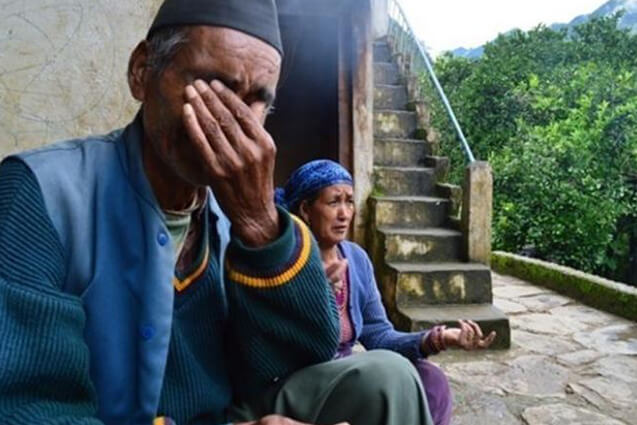Sher Singh and his wife are in their late 70s. Frail and vulnerable, they lost everything to the devastating floods that struck Uttarakhand in mid-June.
When I met them, they had a vacant helpless look on their faces.
Our whole life is meaningless; We lost everything we earned so far!
The floods that ravaged the Kedarnath valley, have left behind a thousand such tales of desolation.
Dhirendra (our volunteer) and I had reached Khonu village, in Kalimath area of Kedarnath, to overlook the relief distribution being carried out by ActionAid India and Mount Valley Development Association (MVDA). This is one of the 128 villages that we are reaching out to as part of our relief and rehabilitation efforts in the State, with the help of local organizations.
The trip to Khonu had its share of risk as access to this village was severely limited. We had to cross the Mandakini river on ropes laid by the Indian Army. These ropes were initially laid to rescue survivors and shift their belongings and are now largely used by local people and relief workers. The trek was a long and steep one that lasted a full day through tough terrains and broken roads.
Sher Singh was shattered beyond words when we first met him. He lost 6 family members, two of them early adolescents. With no one to provide for, it is a bleak future that he and his wife are staring at.
Most of the people, who lost their lives, are between the age group of 18-35. Locals say that the floods struck when most of these young students were home due to school/college holidays. The young adults were around to pitch in and help their folks in reaping the maximum out of a pilgrimage season.
Mules are the most common form of transport here and most of the locals are Mule Riders, Kachharwalas as they are known. During peak seasons, they also set up roadside shops and eating joints to attract the pilgrims. Their livelihoods depended on these tourists and pilgrims who visited to offer their prayers to Lord Siva, a Hindu deity. Local administration suggests that it would be atleast 2-3 years before things return to normalcy and the place would be opened to the tourists/pilgrims.
What the valley has lost is its young bright minds, taken away cruelly – in a flash! It is a grim picture of a village where the elderly and the children are left to fend for themselves.
During the non-touristy seasons, locals here largely depend on agricultural labour. Little remain of that lush green land that once held paddy, potatoes etc. Locals hope that NREGS work would be made available to them as part of the reconstruction work in the area. They believe that, atleast in the short-run, they can sustain their lives by being part of the rebuilding efforts. However, let me also add that most of the locals who worked under various NREGS jobs last year, are yet to receive their payments.
To quote one of the recent updates I had received from the staff working in other parts of the State –
Although Government has announced a host of government schemes and grants for the rehabilitation for the Uttarakhand floods, people here have doubts whether these schemes will actually reach the poor. The performance of the schemes like MGNREGA has been pathetic in the state. For example in Chamoli in 2012-2013, as per the District authorities (District Development Officer – Sandeep Verma in Chamoli) there are outstanding dues to the tune of Rs 32 crores (out of 58 crores, only 26 crores have been disbursed at the village level). According to Laxman Negi of Jandesh, government should immediately clear the outstanding dues of the people so that people have confidence about newly proposed scheme of 150 days under MGNREGA.
It is a point of despair for the locals. They are all genuinely worried about the future.
Essentially, what we all fear is the possibility of distress migration into the cities from this area. Signs are showing, already.
We met a few people who informed us that mid-way through the rescue operations, they met ‘agents’ from nearby cities who landed at the area, offering ‘lucrative jobs’. A few of them even accepted offers to work in factories of Ghaziabad. Or in other words, those youths who survived the floods are now gearing up to migrate to the cities, leaving behind their frail old folks, leaving behind a sustainable life they were leading till a month ago. We have seen this happen before too – in Orissa, in Latur.
I have been associated with ActionAid India’s work in rescuing and rehabilitating bonded labourers and it is a frightening fact that calamities like these are the starting points of a long and tenuous cycle of bondage.
What’s worse? In my stay here so far, I am yet to come across any government official interacting with people and allaying their fears and apprehensions.
Humanitarian organizations like ActionAid and others are reaching out in ways and means that they can – but The State has a responsibility towards its people and in situations like these they must be at the forefront to assure their people that no matter what, we would survive this – together! I am yet to see that happen.
(Chandan is part of the Emergency Response team at ActionAid who are now working in 4 districts monitoring and planning our relief and rehabilitation efforts. You can write to him at chandan.kumar@actionaid.org)
 Author: Chandan Kumar
Author: Chandan Kumar




